
* The PBY Catalina had its roots in a flying boat designed by the Consolidated company, the "P2Y Ranger", designed in the early 1930s. Only a modest number of Rangers was built; it quickly led to an improved successor, the "PBY Catalina", which proved an important player in World War II, being built in large numbers and serving with both US and Allied forces.
* In the 1920s, the Consolidated company of Buffalo, New York -- run by Reuben Hollis Fleet, who had gone from real estate into producing aircraft -- had built a number of flying boats. In 1929, the company performed the first flight of a long-range flying boat for a US Navy requirement, the "XPY-1 Admiral". The type had potential, but to the shock of company officials, the Navy decided that they would put the production contract for the aircraft up for bid, even though the Navy's funding for prototype development hadn't come close to covering Consolidated's development costs.
There was no way that such an unfair business practice would be possible today, but things were different in those days. The Martin company won the production contract for production of the type as the "P3M-1". Martin was handed the prototype, but unsurprisingly Consolidated didn't lift a finger to help them; Martin engineers had to reverse-engineer the machine. The P3M-1 and the improved P3M-2 were only built in small numbers, and the type had a short and forgettable service life.
Consolidated got some satisfaction out of the failure of the P3M, with the company's Reuben Fleet commenting that Martin "underbid us a half-million and lost a million on the job." Consolidated produced a successful commercial airliner version of the Admiral, the "Model 16 Commodore"; then came up with a successor military design, the "Model 22 / P2Y Ranger", with 47 built. The P2Y would lead in turn to one of the most important flying boats of World War II.
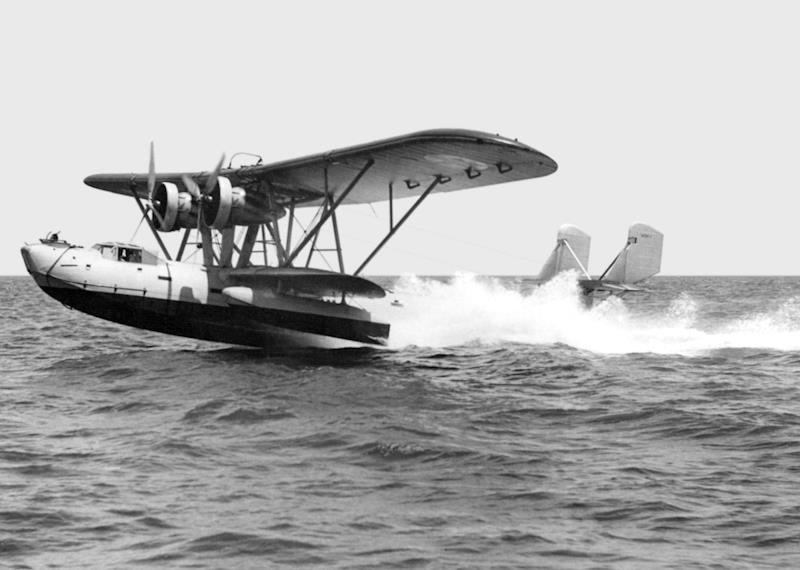
* The Catalina began life as the "Consolidated Model 28" AKA "XP3Y-1" flying boat, designed by a team under Isaac M. "Mac" Laddon at the Consolidated facility in Buffalo, New York -- in response to a Navy order placed with the company, in October 1933, for a maritime patrol aircraft. The XP3Y-1 was a logical progression from earlier Consolidated flying boat designs but was state-of-the-art, being a very clean all-metal monoplane -- except for fabric-covered ailerons -- with a stepped hull, and the braced wing high-mounted on a pedestal above the fuselage, additional support being provided by dual struts from the fuselage. The flight engineer's station was in the pedestal, with living quarters featuring bunks for long patrols in the fuselage midsection. The tailplane was mounted well up the tailfin.
The XP3Y-1 was initially powered by two Pratt & Whitney (P&W) XR-1830-54 Twin Wasp air-cooled radial engines with 615 kW (825 HP) each, driving three-bladed Hamilton Standard variable-pitch propellers. Fuel storage was in the wing center section, capacity being 6,630 liters (1,750 US gallons). One particular innovation was wingtip floats that retracted outward to the wingtips, using a crossbrace scheme.
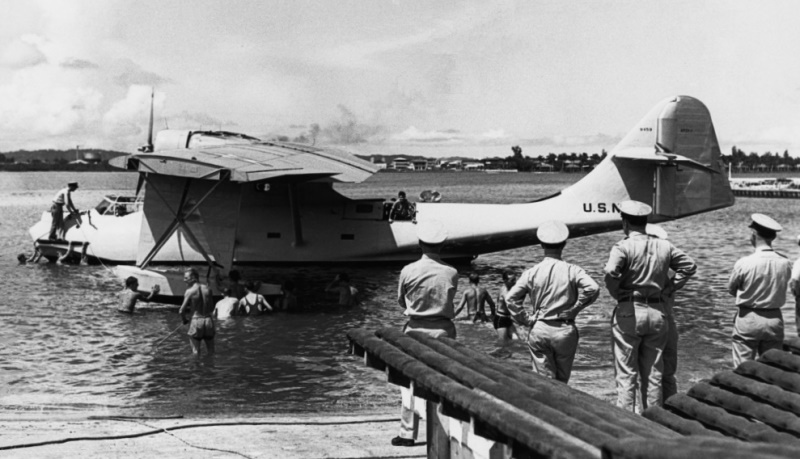
The XP3Y-1 had an enclosed cockpit, a glassed-in nose gun position with a single 7.62-millimeter (0.30-caliber) Browning machine gun, and sliding hatches on each side of the fuselage behind the wing, also each mounting a single 7.62-millimeter Browning; 12.7-millimeter (0,50-caliber) Brownings could be mounted in the hatches instead, with a smaller ammunition supply.
There were two stores racks on each wing outboard of the struts; warloads included up to four 450-kilogram (1,000-pound) bombs, or four 145-kilogram (325-pound) depth charges, or two Mark 13 torpedoes. Bombs were aimed with a Norden bombsight, sighting through a window in the bow, with an external roll-up protective screen.
First flight of the XP3Y-1 was on 21 March 1935, with William B. Wheatley at the controls -- the aircraft being flown from Buffalo to Norfolk, Virginia, a week later for Navy trials. In the course of trials, in October the XP3Y-1 flew from Norfolk to the Panama Canal Zone, non-stop, and then back to San Francisco, also non-stop, a demonstration of its long legs. It was flown back to the factory in October 1935, to be updated to a refined standard, and re-emerge as the "XPBY-1" in May 1936 -- the new designation meaning "Patrol Bomber" and not just "Patrol", "Bomber" indicating a long-range shipping attack role.
On 29 June 1935, well before the end of trials, the Navy had ordered 60 production machines to be designated "PBY-1" -- originally "P3Y-1". The XPBY-1 and PBY-1s featured a set of refinements relative to the XP3Y-1:
There were other tweaky changes, such as refinements to the other gun positions. The PBY-1s were to be built at the Consolidated plant in San Diego, California.
On the completion of trials, the XPBY-1 performed a non-stop flight from Norfolk, Virginia to San Diego, California -- a journey of 5,543 kilometers (3,443 miles), which was a new international distance record. The first production PBY-1, was delivered to the Navy on 5 October 1936, with the last PBY-1s delivered in 1937. Service machines were delivered with beaching wheels that could be attached to the hull to allow the aircraft to be pulled up on shore, as well as folding work platforms that could be hung off the airframe for performing maintenance.
As PBYs were rolled off the assembly line, they were flown in groups to distant duty stations. One unarmed, civilian PBY-1, known as a "Model 28-1", was sold to tropical explorer Dr. Richard Archbold in 1937. Consolidated called this and the other few commercial machines "Catalina", after Catalina Island off the California coast, though the Navy wouldn't formally adopt the name until 1941. This aircraft was to be used to support an expedition into the interior of New Guinea. Archbold gave it the name "Guba", which was Papuan for "fierce storm".
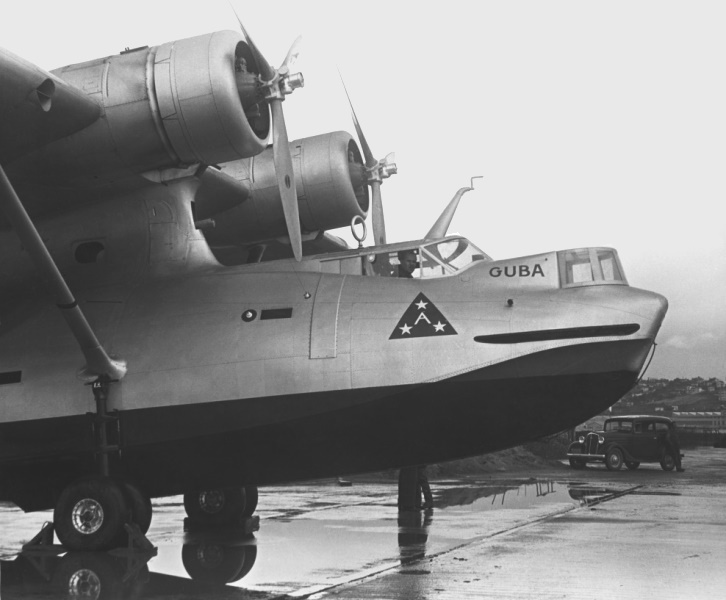
However, the Guba never got to its intended destination; it was bought off for a high-profile search and rescue effort, with Sir Hubert Wilkins hunting for the crew of a lost Soviet trans-Polar flight, under the command of Sigizmund A. Levanesky. The aircraft and its seven crew were never found. The Guba ended up in service to the Soviets for transport use, finally being destroyed in a bombardment by a German submarine of the harbor of the northern island of Novaya Zemlya in July 1942. Three commercial PBY-1s, designated "Model 28-2", were also sold to the Soviet Union as part of a license production package, discussed in more detail later.
BACK_TO_TOP* By the time the first PBY-1s were being delivered to the US Navy, the service had already ordered 50 more "PBY-2" aircraft -- generally similar to the PBY-1, the most prominent change being a redesigned tailplane. They also had Curtiss electric propellers, Hamilton Standard props being the norm for other PBYs. Initial delivery of this variant was in May 1937.
One unarmed PBY-2, known as a "Model 28-3", was sold to Dr. Archbold to replace his "Guba" flying boat, to be of course known as "Guba II". It went ahead with the New Guinea expedition, to later be flown back to the USA -- by the westward route, arriving in New York City for the World's Fair in October 1940.
A further US Navy order for 66 "PBY-3" machines had been placed on 27 November 1936, these aircraft being fitted with P&W R-1830 Twin Wasps with 745 kW (1,000 HP) each. They could be visibly distinguished from PBY-2s by the fact that the carburetor intake was moved from the bottom of the engine nacelles to the top. Deliveries were in 1937:1938.
The next variant, the "PBY-4", was fitted with R-1830-72 engines providing 785 kW (1,050 HP) each; the props had spinners, which were not fitted to any other Catalina variant. 33 were ordered on 18 December 1937, making the PBY-4 the least-produced Catalina variant, with deliveries in 1938:1939. Most of the batch retained the sliding gun-port hatches behind the wing, but the last three featured glassed-in blisters that each mounted a single Browning, and provided excellent observation positions. They would prove such a distinctive feature of the PBY that it's surprising to learn early production didn't have them.
One commercial PBY-4 was built for American Export Airlines, under the designation of "Model 28-4". This machine, named TRANSATLANTIC, was used for route surveys, to ultimately end up in US Navy hands as a transport. Another commercial PBY-4 was sold to the UK for evaluation as the "Model 28-5".
* Total production of PBYs, all by Consolidated in San Diego, including the prototype and up to the PBY-4 was 217. Following the PBY-4, Catalina production would go into high gear. In the wake of the outbreak of war in Europe in September 1939, US President Franklin Delano Roosevelt proposed "Neutrality Patrols" in which US forces would maintain security over the sea lanes well out into the Atlantic. It was classic FDR sleight-of-hand, since it amounted to providing military assistance to the British against the Germans. The US Navy would get into a few shooting matches with German U-boats during the Neutrality Patrols, resulting in American casualties. The whole thing was kept as secret as possible.
On 20 December 1939, the Navy accordingly placed a big order for 200 examples of a considerably improved Catalina, the "PBY-5" -- one of the three PBY-4s with waist blisters being refined as a prototype. The PBY-5 version featured a further revised tailfin featuring a rudder with a straight rear edge, as well a new tailplane, and R-1830-82 Twin Wasp radials with 895 kW (1,200 HP) take-off power. The top-mounted carburetor was relocated to under the top lip of the engine cowling. Later production PBY-5s and all subsequent Catalina variants would feature the R-1830-92, with the same take-off power but better high-altitude performance; they would also feature self-sealing fuel tanks. Initial delivery of the PBY-5 to the US Navy was on 18 September 1940.
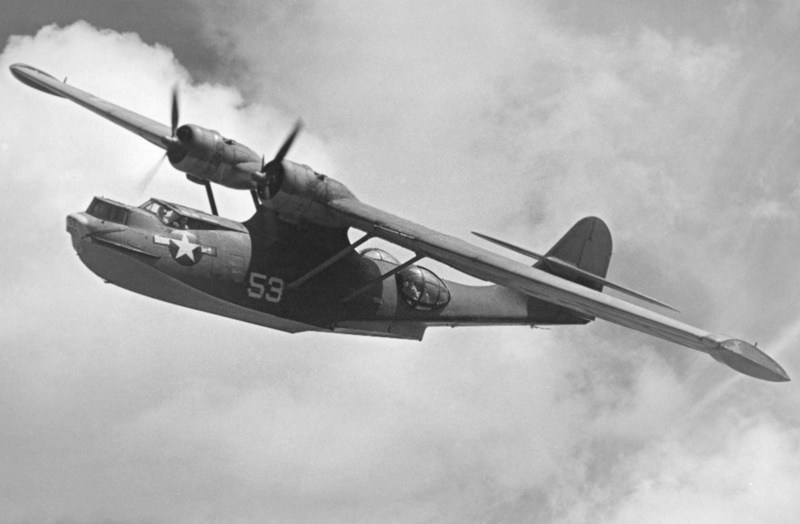
Up to that time, the Catalina had been a pure flying boat, incapable of landing on an airstrip and requiring beaching gear to be brought up on shore. An amphibious version, capable of operating off either land or sea, seemed like a good idea, and in April 1939 the first production PBY-4 went back to the Consolidated factory to be fitted with retractable tricycle landing gear. This machine was rolled out again on 22 November 1939 as the "XPBY-5A". All landing gear were hydraulically-actuated and had single wheels, the nose gear retracting into a closed well, the main gear tucking up and over to the sides. Empty weight increased by almost two tonnes.
___________________________________________________________________
CONSOLIDATED PBY-5A CATALINA:
___________________________________________________________________
wingspan:
31.7 meters (104 feet)
wing area:
130 sq_meters (1,400 sq_feet)
length:
12.22 meters (40 feet 1 inch)
height:
6.15 meters (20 feet 2 inches)
empty weight:
9,845 kilograms (20,910 pounds)
MTO weight:
16,067 kilograms (35,420 pounds)
cruise speed:
180 KPH (115 MPH / 100 KT)
service ceiling:
3,960 meters (13,000 feet)
operational range:
3,780 kilometers (2,350 MI / 2,045 NMI)
___________________________________________________________________
The Navy liked the PBY-5A so much that the last 33 of the order for 200 PBY-5s were completed as PBY-5As, meaning only 167 of that batch were delivered as PBY-5s. The US Army Air Forces also liked the PBY-5A amphibian, obtaining it as the "OA-10A" for the "air-sea rescue (ASR)" role.
Late-production PBY-5As had twin 7.62-millimeter Brownings in a bubble or "eyeball" nose turret. Some PBY-5/5As were fitted with longwave "air-to-surface vessel (ASV)" radar, with a cluttered set of aerials under the wings and tacked on to the fuselage; later, they were often fitted with "centimetric (microwave)" ASV radar -- much superior to the earlier longwave set -- in a teardrop radome on a pylon above and behind the cockpit. In addition, fittings for four "jet assisted take-off (JATO)" solid-fuel rocket bottles were fitted to the fuselage behind the main landing gear. There are images of PBY-5s that also featured a magnetic anomaly detector tailboom, to detect the presence of a submarine underwater; presumably they could drop sonar buoys to get a more precise location of a submarine if one was detected -- and use homing torpedoes to engage it.
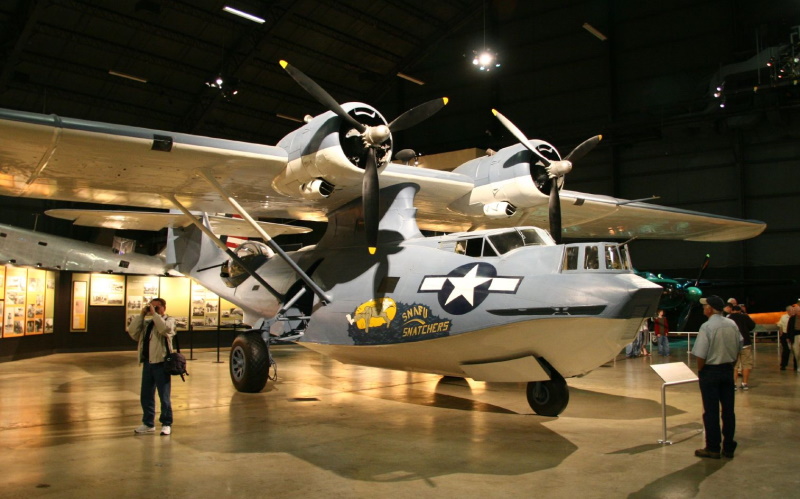
With the introduction of the PBY-5 and PBY-5A, the construction history of the Catalina becomes very confusing. As well as it can be sorted out, production totals for Catalinas from Consolidated / San Diego were 1,174 PBY-5 flying boats, and 769 PBY-5A amphibians. Later in the war, Consolidated operated a plant in New Orleans that turned out one PBY-5 and 59 PBY-5As, for a total of 1,175 PBY-5s and 828 PBY-5As built by Consolidated. They were allocated as follows:
Many of the PBY-5s supplied to US allies were designated "PBY-5B"; they were just PYB-5 flying boats, being given that designation to indicate their distribution via Lend-Lease.
* While Consolidated was refining the PBY, the Naval Aircraft Factory in Philadelphia had also been performing a set of tweaks on the design to improve its aerodynamic and hydrodynamic features. The changes were significant enough to ensure that Consolidated could not build the new design without having to take down the production line and re-tool -- and since interrupting production was out of the question, on 16 July 1941 the US Navy awarded the Naval Aircraft Factory a contract to build 156 examples under the designation of "PBN-1 Nomad". It featured:
Deliveries of the Nomad were badly delayed, with the variant not reaching service until early 1943, and 138 of the order were actually provided to the Soviets under Lend-Lease. 18 went to the US Navy, that number apparently including a prototype.
* The taller tailfin was incorporated into the final Consolidated production version of the Catalina, the "PBY-6A" amphibian. The PBY-6A also had microwave radar by default. 175 were built between April 1944 and April 1945 at the Consolidated plant in New Orleans, Louisiana, mentioned above -- production having been moved from San Diego to New Orleans to allow the San Diego plant to focus on construction of the PB4Y-2 Privateer, a derivative of the B-24 Liberator. 48 of the PBY-6As were provided to the USSR under Lend-Lease, and 75 went to the USAAF as OA-10Bs, the other 52 going to the US Navy.
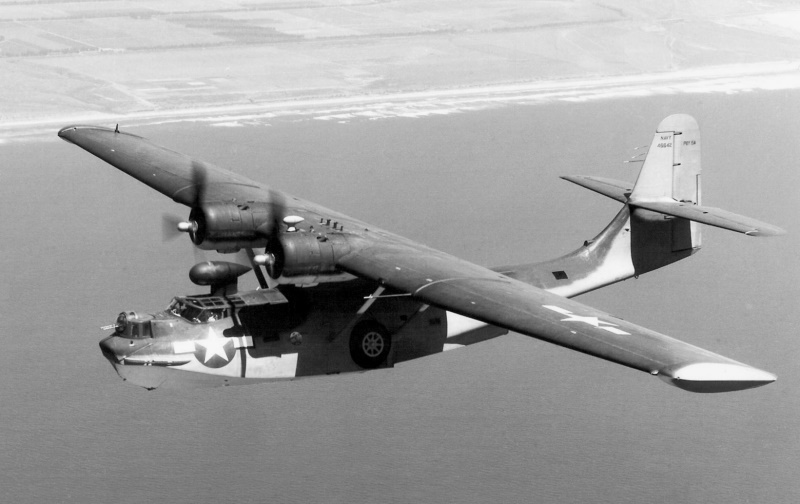
Some sources give New Orleans PBY-6A production as 235, but this appears to be adding in the one PBY-5 and 59 PBY-5As reported to have been built there. In any case, total Consolidated PBY production was 217 + 1,175 + 828 + 175 = 2,395 Catalinas, with 2,160 in San Diego and 235 in New Orleans.
BACK_TO_TOP* The Catalina was in widespread US Navy service when Pearl Harbor was attacked by the Imperial Japanese Navy on 7 December 1941, with dozens PBYs destroyed in the attack.
The Catalina had already seen action of sorts in support of the Atlantic "neutrality patrols", and was immediately in the thick of the action -- helping to hold the line against German U-boats. PBYs suffered badly in the initial onslaught in the Pacific, but their scouting provided badly-needed intelligence to help stem the Japanese tide.
The PBY served in all oceanic theaters, from the Arctic to the tropics. In service, the Catalina was noted for the heaviness of its controls, that apparently being a common issue with Consolidated aircraft. It was also painfully slow and its defensive armament inadequate, making it an easy target for enemy fighters. Its primary virtues were very long range and reliability.
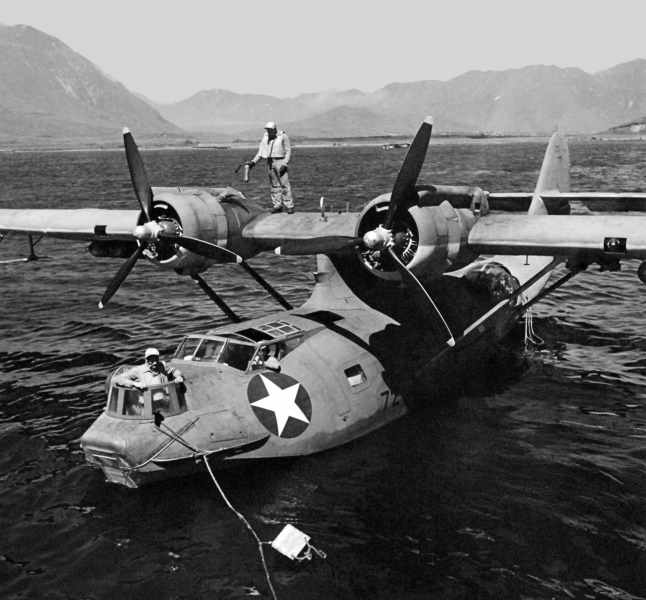
Along with scouting, anti-submarine patrol, and convoy escort, the Catalina gained considerable appreciation from aircrews in the air-sea rescue role, with downed aircrews overjoyed to see a "Dumbo", as they called the PBY, show up to bring them to safety -- sometimes performing rescues under fire. Catalinas were also fitted with a lifeboat under one wing that could be paradropped to survivors.
While the PBY proved highly vulnerable in daylight combat, from late 1942 they increasingly performed attacks on Japanese shipping at night, the black-painted machines being called, of course, "Black Cats". In addition, Catalinas performed aerial minelaying, which proved particular devastating to enemy shipping. A few Catalinas were fitted with a magnetic ring, running from nose to tail and around the wingtips, to detonate magnetic mines. Since the aircraft had to fly low over the water to set off the mines, that could be hazardous.
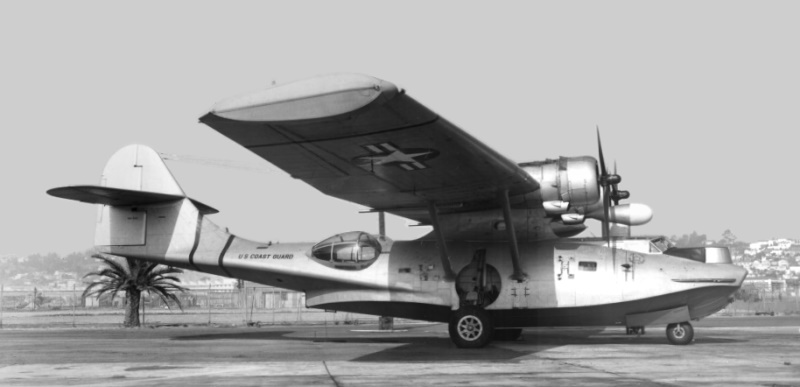
The US Coast Guard, operating under Navy command during the war, operated the PBY in numbers as well. In the postwar period, Catalina flying boats were quickly retired from service, though the amphibians generally soldiered on for years. The last Catalina in US military service, a Navy Reserve PBY-6A, was retired in 1957.
BACK_TO_TOP* Substantial quantities of Catalinas were built outside the USA. As mentioned above, in 1938 the Soviet Union purchased three Model 28-2 / Cargo Mail commercial Catalinas, like the PBY-1, and a manufacturing license from Consolidated, with 18 Consolidated engineers going to Taganrog in the USSR to help set up a production line. One of the Catalinas was flown, then disassembled and sent by cargo ship; the other two were obtained as assemblies, to be used to help establish manufacturing. The first Soviet-built Catalina, which was designated "GST" -- for "Gydro-Samolyot Transportnyi (Cargo Hydroplane) -- was rolled out in 1939, and several hundred more would follow.
The original three Cargo-Mail machines were unique among Western-made Catalinas in having Wright 9-cylinder single-row R-1820-G3 Cyclone radials with 630 kW (840 HP) each, not P&W Twin Wasps. The GST machines were powered by Soviet-made Shvetsov M-62 / ASh-62 radial engines with 750 kW (1,000 HP) each. The ASh-62 was a derivative of the Cyclone, the USSR having obtained a license for manufacture of the Cyclone as the M-25. The GST flying boats also featured other Soviet kit, for example armed machines with Soviet-type machine guns. They were used by the Red Navy for coastal patrol. As mentioned above, the Soviets also obtained 138 PBN-1 Nomad and 48 PBY-6A machines. Details of the Catalina's Soviet service are very unclear; these Catalinas appear to have lingered in service into the 1950s.
* As mentioned above, the Catalina was produced under license in Canada as well. Canadian production was initiated by an agreement between the US and Canadian governments in 1941, with Canadian Vickers LTD at Cartierville, near Montreal, and Boeing Aircraft of Canada at Vancouver tooling up for manufacture of the Catalina. Canadian Vickers focused on the PBY-5A, rolling out their first 3 April 1943, building a total of 369 PBY-5As up to end of production at Cartierville on 19 May 1945.
139 of the Vickers-built amphibians were supplied to the RCAF as the "Canso A". The plan had originally been to supply Vickers-built Catalinas to both the US Navy and the USAAF, the USN machines to be designated "PBV-1A" -- but in the end, the other 230 were supplied to the USAAF under the OA-10A designation.
Boeing's Vancouver plant built Catalinas under license, the first of the Boeing machines performing its maiden flight on 12 May 1943, and produced 362 Catalinas, including:
Total production in Canada was 369 + 362 = 731 Catalinas. Distribution of Canadian production was:
Total production of PBYs in the US and Canada was 3,282, broken down by variant as follows:
Production of the 3,282 Catalinas by source was:
* The primary foreign user of the Catalina was Britain -- or possibly rather the British Commonwealth, with Australia, New Zealand, and Canada so intertwined in the orders as to make it hard to sort things out.
As mentioned earlier, the British Air Ministry bought a Model 28-5 Catalina, a civilianized PBY-4, for evaluation, with this machine flown across the Atlantic to Britain in July 1939. Following the outbreak of war in September 1939, the British ordered a batch of "Catalina Mark I" machines for the Royal Air Force Coastal Command. The original evaluation machine was lost in a crash in early 1940; the British also obtained the Guba II machine from Dr. Archbold for evaluation. The Guba II was later operated by the British Overseas Aircraft Corporation for transport in West Africa -- to then be sidelined, then sunk in a storm, then raised and scrapped.
The Catalina I was very similar to the US Navy PBY-5, featuring comparable R-1830-S1C3-G engines, but had a British armament fit, replacing all four Browning machine guns with 7.7-millimeter (0.303-caliber) Vickers machine guns on flexible mounts. Incidentally, it is said in some sources that the British gave the type the name "Catalina", but it seems much more likely that they picked it up from Consolidated. However, apparently the US Navy then decided to formally adopt the name as well.
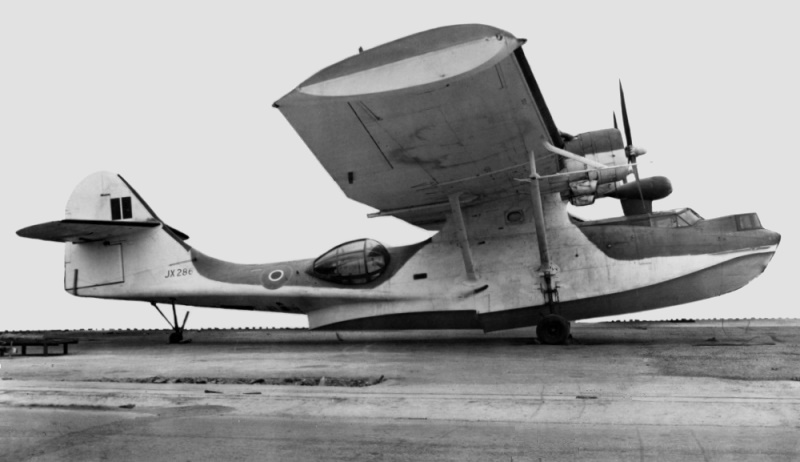
First deliveries of the Catalina I were in early 1941, with the type initially going into service with Coastal Command Number 209 and 240 Squadrons. 99 were obtained, along with seven similar "Catalina Mark II" machines, diverted from the US Navy for expedited delivery.
The Catalina proved a very useful patrol aircraft, in particular spotting the German battleship BISMARCK on 26 May 1941, after the warship had managed to give British Royal Navy forces the slip. US Navy pilots had been helping the RAF get up to speed on the Catalina, with the co-pilot on the aircraft that spotted the battleship being one Ensign L.T. Smith.
The RAF -- along with the RAAF, RNZAF, and the RCAF -- obtained further batches of PBY-5 flying boats from US and Canadian production under a confusing series of marks, including "Catalina IB", "Catalina IIA", "Catalina IIB", "Catalina IVA", "Catalina IVB". The RCAF also, as mentioned, obtained PBY-5s under the "Canso" label. PBY-5A amphibians were obtained by Canada as the "Catalina IA" and "Canso A", with the RAF obtaining a dozen of the type as the type as the "Catalina III". The RAF also obtained the PB2B-2 ("PBY-6") flying boat as the "Catalina VI".
In Commonwealth service, Catalinas were for ASW patrol -- with dozens of kills of enemy submarines credited to "Cats" -- as well as scouting, transport, air drops, and sometimes night attack or minelaying. ASW Catalinas were often fitted with radar -- early on longwave radar, with its clutter of antennas, and later centimetric radar, in a teardrop fairing above and behind the cockpit. Some Catalinas were fitted with a Leigh light, which could illuminate submarines and other targets on the surface at night. The Leigh light was carried under the stores racks of one wing, so Leigh light-equipped Catalinas usually flew alongside a Catalina carrying a full warload.
While the British, Australians, and New Zealanders quickly disposed of their Catalinas following the war, they remained in service with the RCAF into the early 1960s.
Allocation to users was as follows:
This list is very rough, sources not being clear, complete, or consistent on the matter. Transfers of machines between users is another complication; for example, some sources claim that two US Navy PBY-4s were transferred to the RAAF. The only way to get a truly accurate list would be to trace the histories of every Catalina, which would be difficult or impossible.
* British and Commonwealth forces were not the only wartime operators of the Catalina. The French Navy ordered 30 "Model 28-5MF" flying boats in early 1940, though the German occupation of France in the spring of that year ensured that they ended up in British service. The Free French did obtain 30 PBY-5As.
48 were ordered by the Dutch government for the defense of the Dutch East Indies. 36 of the Dutch machines had been delivered up to the conquest of the Dutch East Indies by the Japanese, with nine of these aircraft escaping to Ceylon (now Sri Lanka) to form up Number 321 Squadron in July 1942. The order was fleshed out with the delivery of 12 PBY-5A amphibians, which conducted maritime patrols over the Indian Ocean until they were replaced by Consolidated Liberators in December 1944.
Second-hand Catalinas were provided to many nations that had not used the type during World War II, such users including Argentina, Colombia, Cuba, Denmark, Dominican Republic, Ecuador, Iceland, Israel, Japan, Mexico, Norway, Paraguay, Peru, Philippines, Sweden, and Taiwan. Sweden obtained three; one was shot down by Soviet fighters over the Baltic on 16 June 1952, while on a search for a Swedish military Douglas DC-3 that had been shot down three days earlier while on a signals intelligence mission. The eight crew of the DC-3 were lost, though the five crew of the Catalina were rescued.
* The PBY lingered for decades in the air tanker or "water bomber" role for fighting forest fires, and was also used for photo surveying. Some were modified to "Super Catalina" standard, replacing the P&W R-1830 engines with Wright R-2600 Cyclone radials, providing 1,270 kW (1,700 HP) each. The "Super Cats" were also fitted with a larger tailfin, one suspects primarily to assist with engine-out handling.
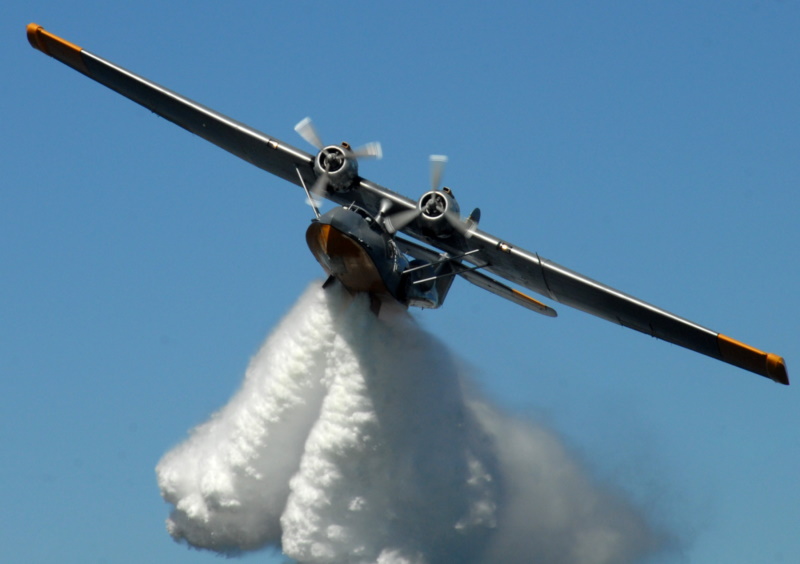
In 1967, the Bird Corporation of the USA converted an ex-RCAF Canso A amphibian to the "Innovator" executive-aircraft configuration -- the most significant change being addition of two Lycoming GSO-480-B2D6 air-cooled flat-six engines, with 250 kW (340 HP) each. The Lycomings were mounted outboard of the original engines; the big Super Cat tailfin was fitted as well. The Innovator was used as a survey platform, one application being the counting of whales. It ended up being parked for some years, and at last notice was being restored to its earlier twin-engine configuration.
Several dozen PBY have survived to the present, with over a dozen still flying, including the air tanker role. Given the utility of the PBY, it is a bit surprising that they're not still being built, flying with turboprop power.
BACK_TO_TOP